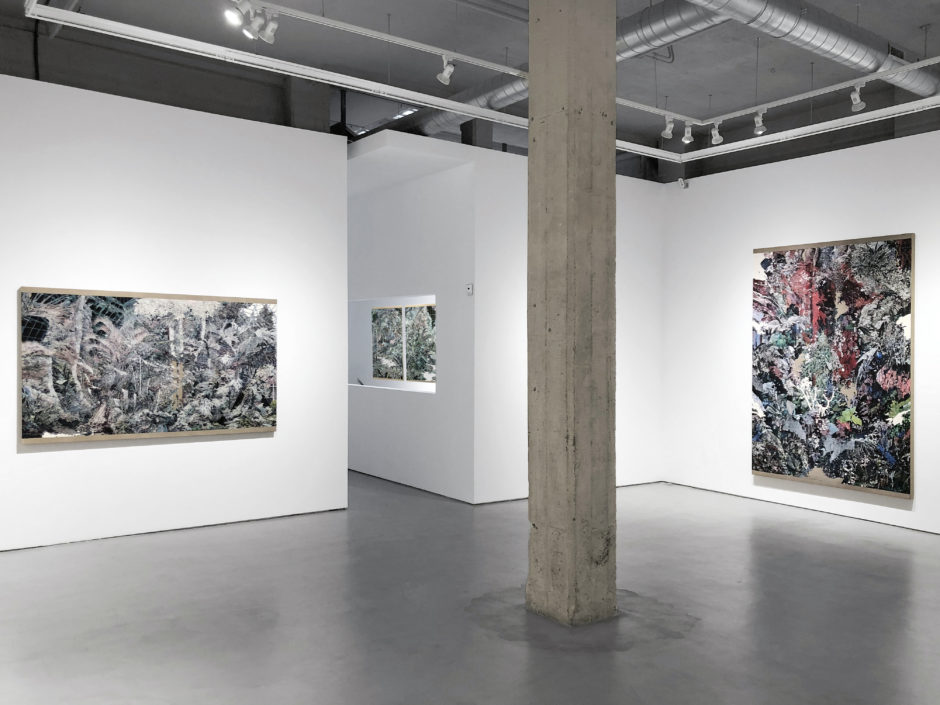
It is easy to forget that seeing is a learned response, and that sight is something we develop from looking at the world. Likewise, we project our thoughts, concepts, identities, and aspirations onto the world. This is the transaction between images and what they symbolize. What we see is rarely simply what it is. Sight is a negotiation between a physical reality, our understanding of that reality, and what we want it to be.
Santiago Giralda’s paintings are precisely this type of negotiation. They present us with something we think we know, or give us a glimpse of something we think we recognize, but through a filter of all of the ideas we have developed about those things. That filter is a conglomeration of many different and sometimes contradictory notions: the empirical and the romantic, the material and the ephemeral, the conceptual and the emotional. He achieves this by taking us– the viewers– back to a basic premise: the place where we dwell, the landscape. And then Giralda recreates it. Not as it is, but as it could be. Through a process that involves a complete manipulation of material, the artist makes us realize that we carry this image of the landscape within us. And, like the pictures of things that we see in the clouds, the image of land and dwelling emerge almost on their own. We project something primal that lives inside of us onto the screen that he creates. Giralda’s paintings, then, become touchstones, or catalysts, for deeply-seated emotions, thoughts, and responses that lay buried within the unconscious until they are triggered by something unexpected. His paintings are the unexpected.
The question of the artificiality of nature arises constantly in Giralda’s paintings. This is paralleled by the way he summons an idea of the natural through wholly unnatural means. The surfaces of Giralda’s paintings are a patchwork of collage elements, abstract bits of paint, and insistent signposts that say, “This is an illusion.” But it is an illusion that happens as much within our minds as in our visual perception. They let the imagination loose but are always tethered to something that is known, not just by our conditioning, but by Giralda’s means of achieving the verisimilitude of the actual. He starts with a photograph that gives a basic structure, but then manipulates it, deconstructs it, and turns it into a fantasy of itself. It is not unlike the mental processes by which we create our own realities from what the world gives us.
We are conditioned to understand beauty in the natural world. As the theologian Thomas Berry said, “We know beauty because the world itself is beautiful.” But how do we apply this to the man-made world, the urban world, and the world that is entirely a construction of our imaginations? If we believe that the world conditions and instructs us, then it stands to reason that our sense of form, balance, proportion, color, and line are also things that we carry within us like a set of rules that nature imbues. It stands to reason, then, that just as Giralda finds the form of nature in the artificial, we too imbue the artificial world with the beauty we have discovered in nature.
There are some basic questions that lie at the base of Giralda’s process. These questions propel his search for images: what is the place of nature and beauty in the urban environment? Is our perception of it changed by its dislocation? What is a botanical garden and how is its meaning changed by its urban context? These questions go to the heart of the Arcadian idyll and remain with us today. Can we come to understand the natural through the artificiality of art? Is any art more than a symbolic representation of something that is absent? And what does it mean that we are constantly looking for the real through abstraction?
Giralda plays with a range of methods that embrace the decorative with a love of material, summoning majestic vistas and intimate glens through the strange allure of industrial surfaces. Through his images, we find ourselves in an unknown place that we think we know. Kit White September 2019
Santiago Giralda (Madrid, 1980). Based in New York. The scope of his project reconsiders the contribution of painting in the technological context our present society stands on. He is interested on the path a picture performs in order to find its new spot in painting. His second solo exhibition in Madrid coincides with the intense work that he has developed in the Master of Fine Arts Painting and Drawing at the Pratt Institute thanks to the Fulbright grant that he was awarded a year after having been granted a fellowship at the Real Academia de España in Rome.
Graduated with a Degree in Fine Art and a Master’s degree in Art, Creation and Research from the Complutense University of Madrid. He also completed a postgraduate course at Hochschule für bildende Künste, Hamburg. His work has been exhibited in the United States, Germany, Philippines, the United Kingdom and Spain. He has shown his paintings at fairs as ARCOmadrid, ArtBo, (Bogotá), ExpoChicago (Chicago) and Art Basel (Hong Kong). Among his most notable solo shows are Habitat (Galeria MPA, New York, 2018), Let the shadow be (Galeria MPA, Madrid, 2015), Interior – Exterior (Sala de Arte Joven, the venue for young artists run by the Regional Government of Madrid, 2009) and Outsider (Galerie Oel-Früh, Hamburg, 2007). (Galería Moisés Pérez de Albéniz press-release)
quepintamosenelmundo: art, contemporary art, art online, spanish art
Galería Moisés Pérez de Albéniz. Calle Doctor Fourquet 20. Madrid
Image: Santiago Giralda “Four Season” Galería Moisés Pérez de Albéniz
